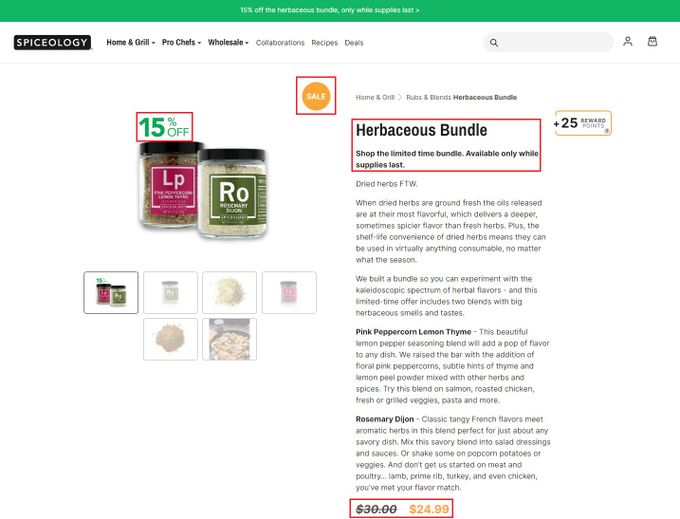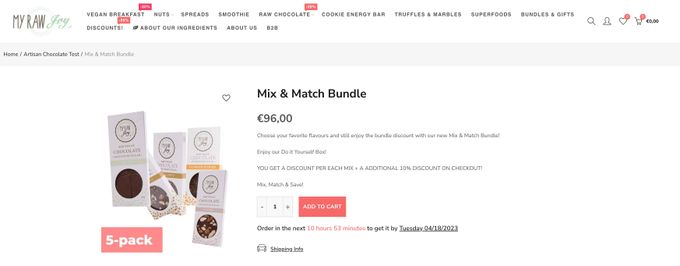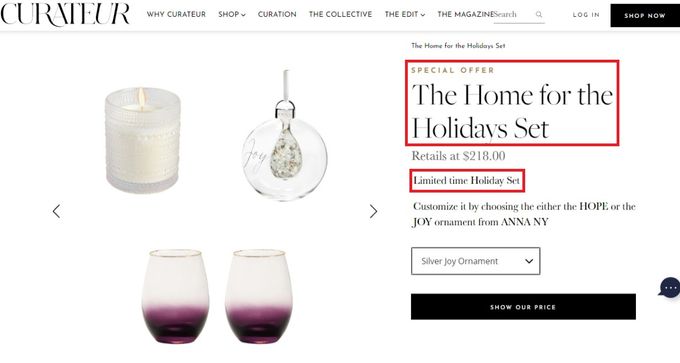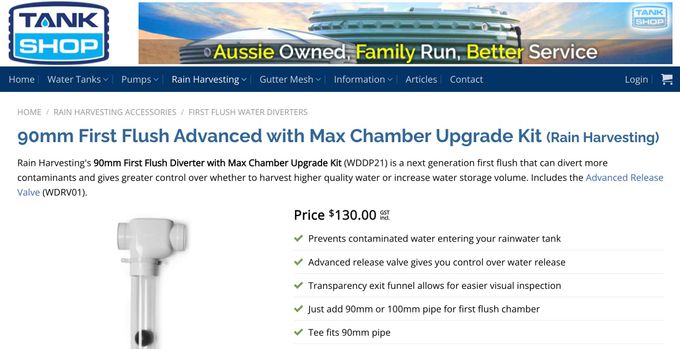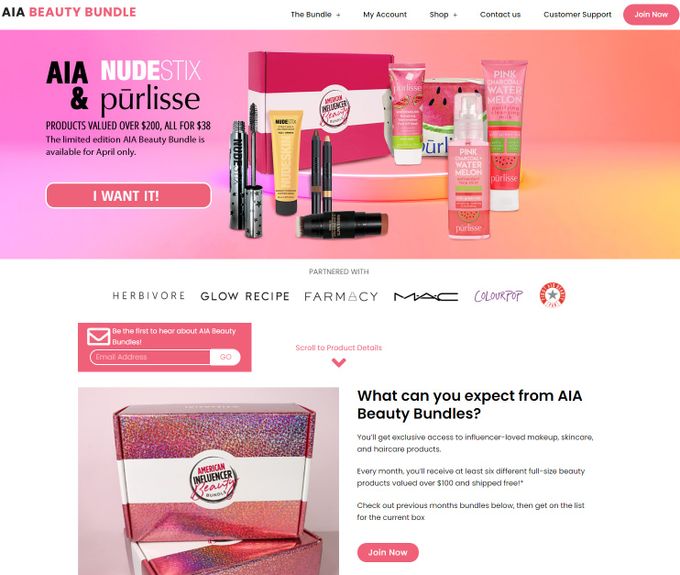Successful eCommerce Product Bundling Guide: Strategies, Examples, & Solutions [2026]
Every shopper loves a good deal. Find out how to create successful product bundles with some help from successful merchandising examples.
Updated December 12, 2025

Product bundles are the ultimate win-win for both your customers and your business. Your customers will love them because they can get more for less. Your business will thrive because bundles increase AOV (by as much as 20%) and keep those slow-selling items flying off the virtual shelves.
Here's everything you need to know about creating successful eCommerce product bundle strategies with practical merchandising examples.
» Leverage product bundling techniques with our merchandising technologies
What Is eCommerce Product Bundling?
Product bundling is when a store owner sells two or more products together as one package, often at a discounted price.
For instance, a PC retailer may offer a bundle that includes a desktop, monitor, and webcam. This tactic aims to increase your profits by enabling you to sell more inventory and provide additional value to your customers.
» Don't forget to leverage the latest eCommerce merchandising trends
5 Product Bundling Strategies and Examples
1. Complementary Bundles
Complementary bundling is the practice of grouping two or more products that are functionally related and selling them at a combined price.
» Confused? Start with the difference between cross-selling and upselling
This cross-selling approach offers several advantages, including improved customer satisfaction and increased sales. Here's how to effectively create a complementary bundle:
- Choose related products: Choose items that naturally complement each other and offer value to customers when bundled together for cross-selling.
- Make it attractive: Offer a discounted price or additional perks to make the bundle irresistible to customers.
- Promote, promote, promote: Market the bundle through various channels to create awareness and generate interest among customers.
» Unsure when it's best to cross-sell? Find out where in the conversion funnel you should cross-sell
Complementary Product Bundle Example: Spiceology's Herb Bundle for Happy Customers
Spiceology is America's fast-growing spice company, offering great deals on herbs, spices, and other seasonings. Their Herbaceous Bundle deal includes two popular dried herb mixes that home and professional chefs are likely to use when experimenting with new flavors.
They clearly display the 15% discount—along with a "Sale" badge—and the original and discounted prices to make sure shoppers don't miss this bundle deal.
This cross-selling strategy works by offering customers a curated selection of products that work well together—at a discounted price—providing them with more value and convenience.
» Get started with these cross-selling tips
2. Custom/Mix-and-Match Bundles
Custom, or mix-and-match, bundles are personalization options that allow customers to pick multiple products from a range of options. Merchants can specify different options for any given product, and customers can choose their preferred ones to create their own custom bundle.
» See our guide to personalization technology
This tailored experience not only boosts customer satisfaction but also encourages brand loyalty and repeat purchases. To create a mix-and-match bundle, you should:
- Empower customers: Let customers choose their own products to bundle, allowing them to curate a personalized package that aligns with their preferences.
- Offer incentives: Provide discounts or exclusive offers for bundling to entice customers to add more items to their cart and increase AOV.
- Simplify navigation: Ensure the bundle is easy to navigate and use, with clear instructions on how to mix different items. A well-thought-out product description can go a long way toward attracting and retaining customers.
» Boost customer satisfaction with a simplified site navigation
Custom Mix-and-Match Product Bundle Example: My Raw Joy
My Raw Joy, an organic snacks store, offers a unique "Mix & Match Bundle" option that allows customers to handpick their desired flavors of raw chocolate bars. This strategy empowers customers to create a customized bundle that aligns with their individual taste preferences.
The result is a delightful and personalized snacking experience that encourages customers to make repeat purchases.
» Ready to create custom bundles? Book a demo today
3. Seasonal Bundles
Seasonal bundles are curated product packages that are designed to align with specific seasons, events, or holidays.
You can offer timely and relevant products to customers with these bundles. For example, you can create special bundles for the summer holidays, ski season, Thanksgiving, etc. Below are the steps to creating your seasonal bundle:
- Choose relevant products: Choose products that are aligned with the season or holiday you're targeting. For example, heart-shaped chocolates for Valentine's Day.
- Add value: Encourage customers to purchase the seasonal bundle by offering a special discount or added value. This could be a percentage off the total bundle price or exclusive seasonal packaging.
- Promote effectively: Promote the seasonal bundle through various channels. Highlight the limited-time nature of the bundle to create a sense of urgency and excitement among customers.
» See our best practices for seasonal eCommerce merchandising
Seasonal Bundle Example: CURATEUR
A great example of a Christmas bundle comes from CURATEUR, an eCommerce retail community offering products hand-selected by renowned stylist Rachel Zoe. The company offers a "Home for the Holidays Set," which is available for a limited time only. This strategy created a sense of urgency, enticing customers to make a purchase.
By offering a prepackaged bundle, CURATEUR made it convenient for customers to shop for Christmas-themed items, enhancing the overall customer experience during the holiday season.
» Explore more best practices to sell seasonal products
4. Upgrade Bundles
Upgrade bundles are collections of premium or high-margin products that businesses use to upsell and cross-sell to customers.
For example, a computer brand may offer an upgrade bundle featuring a higher-priced, more advanced laptop model along with additional accessories or features. This strategic approach not only improves profitability but also lets you provide a memorable customer experience. Here are the steps to create an upgrade bundle:
- Choose higher-end versions: Choose upgraded versions or additional features that complement the original product.
- Offer incentives: Offer perks like freebies or exclusive bonuses to encourage customers to opt for the upgrade bundle.
- Market it well: Use social media proofing, newsletters, and influencer marketing to highlight the unique value of the upgrade bundle.
» Consider utilizing personalized product recommendations
Upgrade Bundle Example: Tank Shop
Tank Shop, a retailer of high-quality bathroom fixtures, uses an effective bundling strategy by offering an upgrade bundle for its toilet flush. This bundle includes a Max Chamber Upgrade Kit with additional features such as a dual-flush mechanism and water-saving options.
This strategy creates added value for customers, incentivizes them to upgrade their purchases, and can result in increased sales for the business.
» Take a closer look at how to choose which products to upsell
5. Subscription Bundles
Subscription bundles are a convenient way for merchants to offer a recurring subscription service that includes a carefully chosen collection of products or services.
Customers can choose the frequency of delivery, such as weekly, monthly, or bi-monthly, and receive the bundled items on a regular basis without having to reorder each time. This approach provides convenience to customers and a recurring revenue stream to businesses. To create your first subscription bundle, you'll need to:
- Choose suitable items: Select products that are well-suited for a subscription model, such as consumables, replenishable items, or complementary products that work well together.
- Provide incentives: Motivate customers to subscribe by offering incentives such as free shipping, loyalty rewards, or personalized upsell and cross-sell product recommendations based on their preferences.
- Promote effectively: Highlight the convenience and benefits of the subscription model while promoting your bundle via social media or email and SMS marketing.
» See these creative ways to display your eCommerce merchandise
Monthly Subscription Bundle Example: AIA Beauty Bundle
A great example of a subscription bundle is the AIA Beauty Bundle, which includes a curated selection of skincare and beauty products delivered to customers on a monthly basis. This subscription bundle makes sense as skincare and beauty products are typically used regularly and require replenishment.
The convenience of receiving such products on a recurring basis saves customers time and effort while also generating recurring revenue for the brand.
» Explore the main benefits of a subscription-based eCommerce model
Solutions to eCommerce Product Bundling Disadvantages
While product bundling is undoubtedly a great strategy for many eCommerce businesses, it does come with a few disadvantages. Thankfully, they aren't that difficult to work around:
Higher Cost
Product bundles will cost more than if customers bought just one of the products individually. While this might deter some customers, you can avoid this by ensuring the bundles have great value for money (and clearly showcasing this benefit) or by offering services like custom bundles and buy now, pay later.
Missed Opportunities
Customers may miss your product bundles if you don't show them clearly. Ensure that you display them in key areas of your website and leverage impulse decision-making or FOMO (fear of missing out) by creating a sense of urgency with time-sensitive deals or offering them during the checkout process and upon immediate arrival to your site.
Misunderstanding of the Right Bundles
It can be difficult to know what kind of bundles you should be using in your store. Consider using customer segmentation strategies through browsing data (like what they buy together and when) to help understand your audience and offer personalized bundles.
Avoidance of Singular Items
Your customers may avoid purchasing singular products in favor of higher-value bundles. You can mitigate this by cycling temporary bundles and conducting A/B tests to check which bundles have an overall benefit to your store.
Fast Forward Your Business Success With eCommerce Product Bundles
Keep in mind that product bundles are the secret sauce to sweetening your eCommerce offerings, but it's not just about tossing random items together. Embrace the power of testing and refining your product bundling strategies based on customer feedback, market trends, A/B testing, and data analysis.
With strategic product bundling, your customers will come back for more, and your business will thrive!
» Bundles are just the start. Learn more about upsell & cross-sell personalization to boost sales

